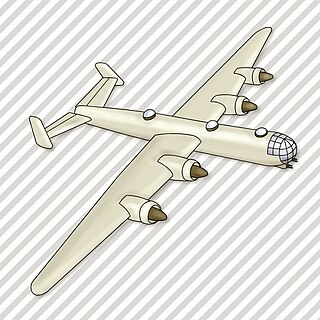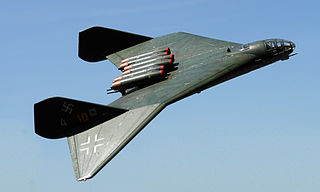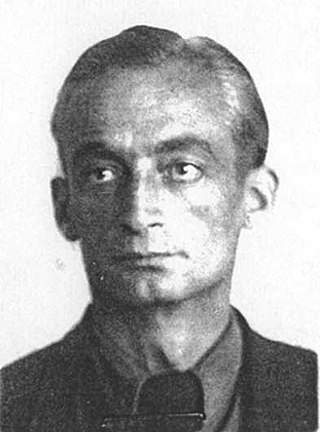
The Heinkel He 111 is a German airliner and bomber designed by Siegfried and Walter Günter at Heinkel Flugzeugwerke in 1934. Through development, it was described as a "wolf in sheep's clothing". Due to restrictions placed on Germany after the First World War prohibiting bombers, it was presented solely as a civil airliner, although from conception the design was intended to provide the nascent Luftwaffe with a heavy bomber.

The Arado Ar 234 Blitz is a jet-powered bomber designed and produced by the German aircraft manufacturer Arado. It was the world's first operational turbojet-powered bomber, seeing service during the final years of Second World War.

Heinkel Flugzeugwerke was a German aircraft manufacturing company founded by and named after Ernst Heinkel. It is noted for producing bomber aircraft for the Luftwaffe in World War II and for important contributions to high-speed flight, with the pioneering examples of a successful liquid-fueled rocket and a turbojet-powered aircraft in aviation history, with both Heinkel designs' first flights occurring shortly before the outbreak of World War II in Europe.

The Amerikabomber project was an initiative of the German Ministry of Aviation (Reichsluftfahrtministerium) to obtain a long-range strategic bomber for the Luftwaffe that would be capable of striking the United States from Germany, a round-trip distance of about 11,600 km (7,200 mi). The concept was raised as early as 1938, but advanced plans for such a long-range strategic bomber design did not begin to appear before Reichsmarschall Hermann Göring until early 1942. Various proposals were put forward, but these plans were all eventually abandoned as they were too expensive, too reliant on rapidly-diminishing materiel and production capacity, and/or technically unfeasible.

The Heinkel He 177 Greif (Griffin) was a long-range heavy bomber flown by the Luftwaffe during World War II. The introduction of the He 177 to combat operations was significantly delayed, by both problems with the development of its engines, and frequent changes to its intended role. Nevertheless, it was the only long-range, heavy bomber to become operational with the Luftwaffe during the war. The He 177 had a payload/range capability similar to that of four-engined heavy bombers used by the Allies in the European theatre.

The Heinkel He 274 was a German heavy bomber design developed during World War II, purpose-designed for high-altitude bombing with pressurized crew accommodation. Due to the Allied advance through Northwest Europe, the prototypes were abandoned at the French factory where they were being built. They were completed after the war by the French and used for high-altitude research.

The Heinkel He 277 was a four-engine, long-range heavy bomber design, originating as a derivative of the He 177, intended for production and use by the German Luftwaffe during World War II. The main difference was in its engines. The He 177 used two Daimler-Benz DB 606 "power system" engines, each of which consisted of two combined Daimler-Benz DB 601 engines, each DB 606 weighed 1.5 tons. The He 177A-3 and its successors used two DB 610 "power system" engines, each of which consisted of two combined Daimler-Benz DB 605 engines, each DB 610 weighed 1.5 tons. Due to problems with both the DB 606 and the DB 610, the He 277 was intended to use four unitized BMW 801E 14-cylinder radial engines, each mounted in an individual nacelle and each turning a three-blade, four-meter diameter propeller.

The Messerschmitt Me 264 was a long-range strategic bomber developed during World War II for the German Luftwaffe as its main strategic bomber. The design was later selected as Messerschmitt's competitor in the Reichsluftfahrtministerium's Amerikabomber programme, for a strategic bomber capable of attacking New York City from bases in France or the Azores.

Henschel's Hs 132 was a World War II dive bomber and interceptor aircraft of the German Luftwaffe that never saw service. The unorthodox design featured a top-mounted BMW 003 jet engine and the pilot in a prone position. The Soviet Army occupied the factory just as the Hs 132 V1 was nearing flight testing, the V2 and V3 being 80% and 75% completed.

The Junkers Ju 290 was a large German, four-engine long-range transport, heavy bomber and maritime patrol aircraft used by the Luftwaffe late in World War II that had been developed from an earlier airliner.

The Emergency Fighter Program was the program that resulted from a decision taken on July 3, 1944 by the Luftwaffe regarding the German aircraft manufacturing companies during the last year of the Third Reich.

The Arado E.555 was a long range strategic bomber proposed by the German Arado company during World War II in response to the RLM's Amerikabomber project. The E.555 designation was applied to a series of long range jet bomber designs of various sizes, powerplant, crew and weapon load configurations. As design studies only, no aircraft were developed or constructed and the entire E.555 project was cancelled at the end of 1944.
The Focke-Wulf Ta 400 was a large six-engined heavy bomber design developed in Nazi Germany in 1943 by Focke-Wulf as a serious contender for the Amerikabomber project. One of the first aircraft to be developed from components from multiple countries, it was also one of the most advanced Focke-Wulf designs of World War II, though it never progressed beyond a wind tunnel model.

Walther Wever was a pre-World War II Luftwaffe Commander. He was an early proponent of the theory of strategic bombing as a means to wage war, while supporting the theories of Giulio Douhet. He died in an air crash in 1936.

The Messerschmitt P.1112 was a proposed German jet fighter, developed by Messerschmitt AG during the closing stages of World War II, and intended for use by the Luftwaffe. The progress of the war prevented the completion of a prototype before the fall of Nazi Germany. Its design, however, had a direct influence on postwar US Navy carrier fighters.

Siegfried Knemeyer was a German aeronautical engineer, aviator and the Head of Technical Development at the Reich Ministry of Aviation of Nazi Germany during World War II.

The Focke-Wulf 1000x1000x1000, also known as Focke-Wulf Fw 239, was a twinjet bomber project for the Luftwaffe, designed by the Focke-Wulf aircraft manufacturing company during the last years of the Third Reich.
The Messerschmitt P.1107 was a jet-powered bomber project developed in the final years of the Second World War.
















